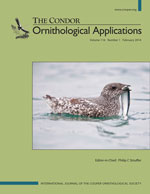Estuarine intertidal habitats are heterogeneous, therefore migratory shorebirds are expected to forage in microhabitats where they can maximize their energy intake. Identifying proximate factors that migratory shorebirds use to accept or reject a particular habitat patch will help land managers make conservation and restoration decisions that provide the greatest benefits to shorebird populations during migration, a period of intense energy usage. We examined whether small semipermanent tidal channels were preferentially used by foraging Western Sandpipers (Calidris mauri) and Dunlins (C. alpina) during a spring migratory stopover in Bandon Marsh, an Oregon, USA, estuary. Further, we tested alternative hypotheses about how channels might be beneficial to shorebirds by examining infauna abundance, composition, and depth alongside channels compared with that in open mudflats. The densities of Western Sandpipers and Dunlins were at least 4 times higher along channels than in open mudflat habitats. Infauna along channels were twice as abundant as those in the surrounding mudflats, and infauna were generally found closer to the surface. Furthermore, sediment alongside channels required less than half the force to probe, probably increasing shorebirds' overall access to prey. We conclude that shorebirds selected microhabitats near channels because of the greater food abundance and availability. Additional evidence suggested that another microhabitat, patches of red algae (Gracilaria sp.), may also have conferred advantages on foraging shorebirds. Channels may be a valuable microhabitat to consider when selecting conservation areas for shorebirds, and maintaining channels (e.g., through maintaining natural hydrology and sedimentation patterns) should be considered in management practices.
How to translate text using browser tools
22 January 2014
Small tidal channels improve foraging opportunities for Calidris shorebirds
Aileen K. Miller,
Catherine E. de Rivera
ACCESS THE FULL ARTICLE

The Condor
Vol. 116 • No. 1
February 2014
Vol. 116 • No. 1
February 2014
Benthic infauna
channel
Dunlin
estuary
microhabitat
Western Sandpiper




